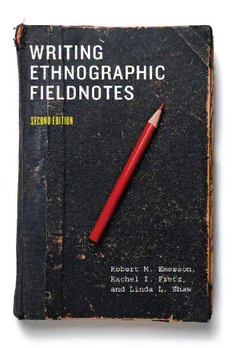Table Of ContentWRITING
ETHNOGRAPHIC
FIELDNOTES
SECOND EDITION
WRITING
ETHNOGRAPHIC
FIELDNOTES
SECOND EDITION
Robert M. Emerson
Rachel I. Fretz
Linda L. Shaw
THE UNIVERSITY OF CHICAGO PRESS • CHICAGO AND LONDON
robert m. emerson is professor emeritus in the Department of Sociology
at the University of California, Los Angeles. He is the author of Contemporary Field
Research: Perspectives and Formulations, now in its second edition. rachel i.
fretz is a lecturer in the Writing Programs unit at UCLA. linda l. shaw is
professor in and chair of the sociology department at California State University,
San Marcos.
The University of Chicago Press, Chicago 60637
The University of Chicago Press, Ltd., London
© 1995, 2011 by The University of Chicago
All rights reserved. Published 2011.
Printed in the United States of America
20 19 18 17 16 15 14 13 12 11 1 2 3 4 5 6 7 8 9
isbn- 13: 978-0-226-20683-7 (paper)
isbn- 10: 0-226-20683-1 (paper)
Library of Congress Cataloging- in-Publication Data
Emerson, Robert M.
Writing ethnographic fi eldnotes / Robert M. Emerson, Rachel I. Fretz,
Linda L. Shaw. — 2nd ed.
p. cm. — (Chicago guides to writing, editing, and publishing)
isbn- 13: 978-0-226-20683-7 (pbk.: alk. paper)
isbn- 10: 0-226-20683-1 (pbk.: alk. paper)
1. Ethnology—Authorship. 2. Ethnology—Fieldwork. 3. Ethnology—
Research. 4. Academic writing. I. Fretz, Rachel I. II. Shaw, Linda L. III. Title.
gn307.7.e44 2011
808(cid:2).066305—dc22
2011016145
o This paper meets the requirements of ansi/ niso z39.48-1992
(Permanence of Paper).
To our friend and colleague,
Mel Pollner (1940– 2007)
Contents
Preface to the Second Edition ix
Preface to the First Edition xiii
1 Fieldnotes in Ethnographic Research 1
Ethnographic Participation 2
The Complexities of Description 5
Inscribing Experienced/ Observed Realities 12
Implications for Writing Fieldnotes 15
Refl ections: Writing Fieldnotes and Ethnographic Practice 18
2 In the Field: Participating, Observing, and Jotting Notes 21
Participating in Order to Write 24
What Are Jottings? 29
Making Jottings: How, Where, and When 34
Refl ections: Writing and Ethnographic Marginality 41
3 Writing Fieldnotes I: At the Desk, Creating Scenes on a Page 45
Moving from Field to Desk 48
Recalling in Order to Write 51
Writing Detailed Notes: Depiction of Scenes 57
Narrating a Day’s Entry: Organizational Strategies 74
In- Process Analytic Writing: Asides and Commentaries 79
Refl ections: “Writing” and “Reading” Modes 85
4 Writing Fieldnotes II: Multiple Purposes and Stylistic Options 89
Stance and Audience in Writing Fieldnotes 90
Narrating Choices about Perspective 93
Fieldnote Tales: Writing Extended Narrative Segments 109
Analytic Writing: In- Process Memos 123
Refl ections: Fieldnotes as Products of Writing Choices 126
5 Pursuing Members’ Meanings 129
Imposing Exogenous Meanings 131
Representing Members’ Meanings 134
Members’ Categories in Use: Processes and Problems 151
Race, Gender, Class, and Members’ Meanings 158
Local Events and Social Forces 166
Refl ections: Using Fieldnotes to Discover/ Create Members’ Meanings 167
6 Processing Fieldnotes: Coding and Memoing 171
Reading Fieldnotes as a Data Set 173
Open Coding 175
Writing Code Memos 185
Selecting Themes 188
Focused Coding 191
Integrative Memos 193
Refl ections: Creating Theory from Fieldnotes 197
7 Writing an Ethnography 201
Developing a Thematic Narrative 202
Transposing Fieldnotes into Ethnographic Text 206
Producing a Completed Ethnographic Document 229
Refl ections: Between Members and Readers 241
8 Conclusion 243
Notes 249
References 269
Index 283
Preface to the Second Edition
Over the past twenty- fi ve years or so, ethnography has become a widely rec-
ognized and generally accepted approach to qualitative social research. But
ironically, in the years since the publication of the fi rst edition of Writing
Ethnographic Fieldnotes in 1995, the surge of interest in ethnographic writing
we noted at that time seemingly has receded. Sociologists and anthropolo-
gists no longer take up the complexities of representation in ethnography as
frequently as they did in the 1980s and 1990s; they offer fewer considerations
of the nature and effects of writing in ethnographic research than in those
decades, although these issues seem to remain lively concerns in commu-
nity studies and writing programs. But the earlier concern with the pro-
cesses of writing fi eldnotes, as opposed to polished ethnographic articles
and monographs, does appear to have made signifi cant marks on the prac-
tice of ethnography: Some ethnographers now publish articles on key issues
and processes in writing fi eldnotes, including Warren (2000) and Wolfi nger
(2002). In addition, and probably more signifi cantly, some ethnographic an-
thologies (e.g., Atkinson, Coffey, Delamont, Lofl and, and Lofl and’s Hand-
book of Ethnography) and qualitative research guides (e.g., Lofl and, Snow,
Anderson, and Lofl and, Analyzing Social Settings, fourth edition; Warren and
Karner, Discovering Qualitative Methods: Field Research, Interviews, and Anal-
ysis, second edition) now provide extended discussions of how to produce
and work with fi eldnotes. These developments provide some indication that

